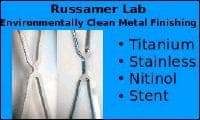world gathers for metal finishing
Q&As since 1989
-----
On-site 'out of the tank' Electropolishing process
Q. I need to Electropolish a Large vessel of 8 ft. diameter and 16 ft. height. Is there any other process than dipping to achieve the Electropolishing of such large components. Please help.
thank you.
engineer - Belgaum, Karnataka, India
November 17, 2009
A. Some people use brush plating techniques to electropolish stainless, but I do not think that it is a practical method for an item as huge as what you want.
Safety of the operator needs to be a primary decision and a difficult one.
- Navarre, Florida
November 18, 2009
A. I agree with James - brush plating technology is your way forward. I suggest you don't try to do too much at once, and take the job in small steps; otherwise you will need some horrendous voltages.

Trevor Crichton
R&D practical scientist
Chesham, Bucks, UK
November 19, 2009
Conductive pads for Electropolishing
Q. He have five SS316 plates (3x1,5m) that a client asked us to electropolish for a custom process that they have. So we currently use electrically conductive brushes (carbon fiber/copper) and using those brushes for such big area would require a LOT of time.
We are thinking about using a pad to cover a bigger area. (0,1m^2) Maybe using a piece of ceramic fiber (which doesn't conduct electricity) dipped heavily in the electrolyte. Or perhaps using an electrically conductive pad ... Although we don't know which material we could use, perhaps just carbon fiber cloth dipped in electrolyte.
Could you guys please recommend to me a material for this endeavour?
Thanks
Q&A Dept - Dusseldorf, Germany
February 2, 2017
"Electroplating Engineering Handbook"
by Larry Durney
on
AbeBooks
or
eBay
or
Amazon
(affil links)
A. Hi Leslie. You used a gmail address and provided no other company info so I don't know what kind of an enterprise your company is. The reason I am curious is because I don't think you are necessarily approaching this job the best way. This doesn't sound like an appropriate application for brush electroplating -- but rather for sending out for conventional electropolishing by dipping. This would be a relatively small, simple, and fast job for conventional tank electropolishing rather than a development program for brush electropolishing. The Electroplating Engineering Handbook has an excellent chapter on the subject, and Metal Coating Process Corp. could advise you further. Good luck.
Regards,

Ted Mooney, P.E. RET
Striving to live Aloha
finishing.com - Pine Beach, New Jersey
February 2, 2017
A. Ted's correct. These plates *could* be brush electropolished, but it would be a messy and time consuming job.
A company doing tank electropolishing would make quick work of them and likely produce better results.

Jeffrey Holmes, CEF
Spartanburg, South Carolina
A. Leslie,
You need to have a special electrolyte to do pad-local electropolishing.
adv.
We use Universal electrolyte that does not leave etched areas on the borders during local electropolishing. Bama Technologies from Turbigo, Italy, licensed our Universal Electrolyte and local polishing device design. You can ask them to sell you some electrolyte. Or contact us for Universal Electrolyte pad polishing technology.

Anna Berkovich
Russamer Lab
Pittsburgh, Pennsylvania

March 17, 2017
Brush on Electropolishing
Q. We are trying to remove weld discoloration from an item that is made from 316, 304, and 430 stainless steel. It's going to be mechanically polished on most of the surface, but there are internal parts that have been welded in that they want the color removed and cannot get to easily mechanically.
We have an electropolish system, but it's not quite right for this type of application where we just want to remove the discoloration locally, and not electropolish the whole piece.
I've seen youtube videos of brush electropolish set ups, has anyone have any experience with these? I'm wondering about material removal, as the part has some tight tolerances, and effectiveness.
Shop Employee - Portland, Oregon USA
April 4, 2019
Q, A, or Comment on THIS thread -or- Start a NEW Thread
